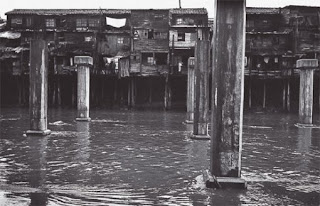During the Joseon Period (1392-1897), Cheonggyecheon was a stream running through the centre of Seoul from east to west.
The 600-year history of Seoul began when King Taejo, the founder of the Joseon Dynasty, moved the capital to Hanyang (today’s Seoul) in 1394. Since then, the Cheonggyecheon has been inextricably linked to Seoul’s history.
The 600-year history of Seoul began when King Taejo, the founder of the Joseon Dynasty, moved the capital to Hanyang (today’s Seoul) in 1394. Since then, the Cheonggyecheon has been inextricably linked to Seoul’s history.
Problems associated with the stream such as its tendency to flood, led to talk of its covering as early as the Joseon period. However, King Taejong (1400-1418) opposed this notion, reasoning that it was against nature to do so. Instead, between 1406 and 1412, Taejong deepened and widened the river and built dykes to control the flooding.
His successor, King Sejong continued this work, digging ditches that diverted some of the water from the tributaries in an attempt to prevent flooding in the city, resulting in the streams early name, the Gaecheon, which means ‘digging out’. Whilst some believed the water should be kept clean, following the principles of Feng Shui, others felt the growing city needed a waterway to carry out its sewage, with Cheonggyecheon the chosen channel.
In 1914, during the Japanese occupation of Korea, Cheonggyecheon got its current name. Cheonggyecheon means ‘clear water stream’, though the Japanese sometimes called it the Takgyecheon, meaning ‘dirty water stream’, because the river had degenerated into a polluted sewer. Despite the pressing need to address the rapidly worsening situation, during this time, financial difficulties prevented the colonialists from tackling Cheonggyecheon.
After experiencing a series of historical events including independence from Japanese colonization in 1945 and the Korean War (1950–1953), South Korea initiated an age of rapid industrialisation. The name of Gyeongsung was changed to Seoul, which became the capital of the new independent modern country (the Republic of Korea), which had transformed into a busy modern city. The capital Seoul needed more roads as a result of its rapid urbanisation and increasing population. It appeared the most beneficial way to put an end to the multitude of shabby, makeshift houses and to improve traffic conditions, was to cover up the stream, Cheonggyecheon.
The initial covering of a short section was first completed in 1955 whilst the full-scale work to cover up the stream with concrete finally began in August 1958 under the direction of South Korean President Syngman Rhee.
Later, in 1968 during the presidency of Park Chung-hee, an elevated highway and its branch roads were built over the road. For more than 40 years these were among the busiest roads in Seoul, becoming the symbol of Seoul’s industrialisation, urbanisation and modernisation within post-war Korea.
However, in 2002 major changes were made to Cheonggyecheon ultimately transforming the urban spatial form of modern Seoul.





